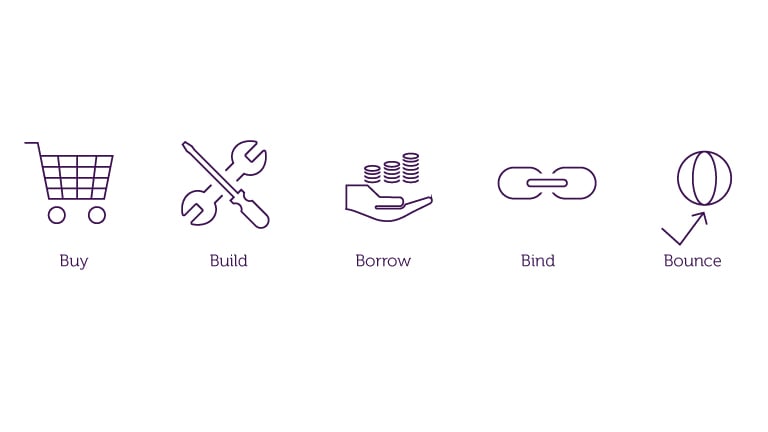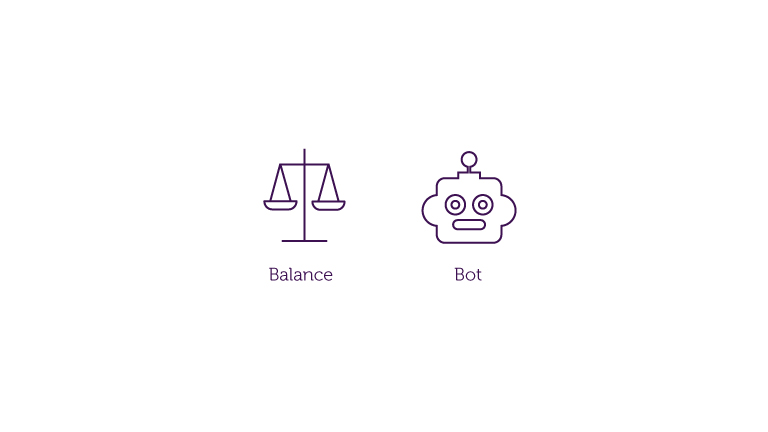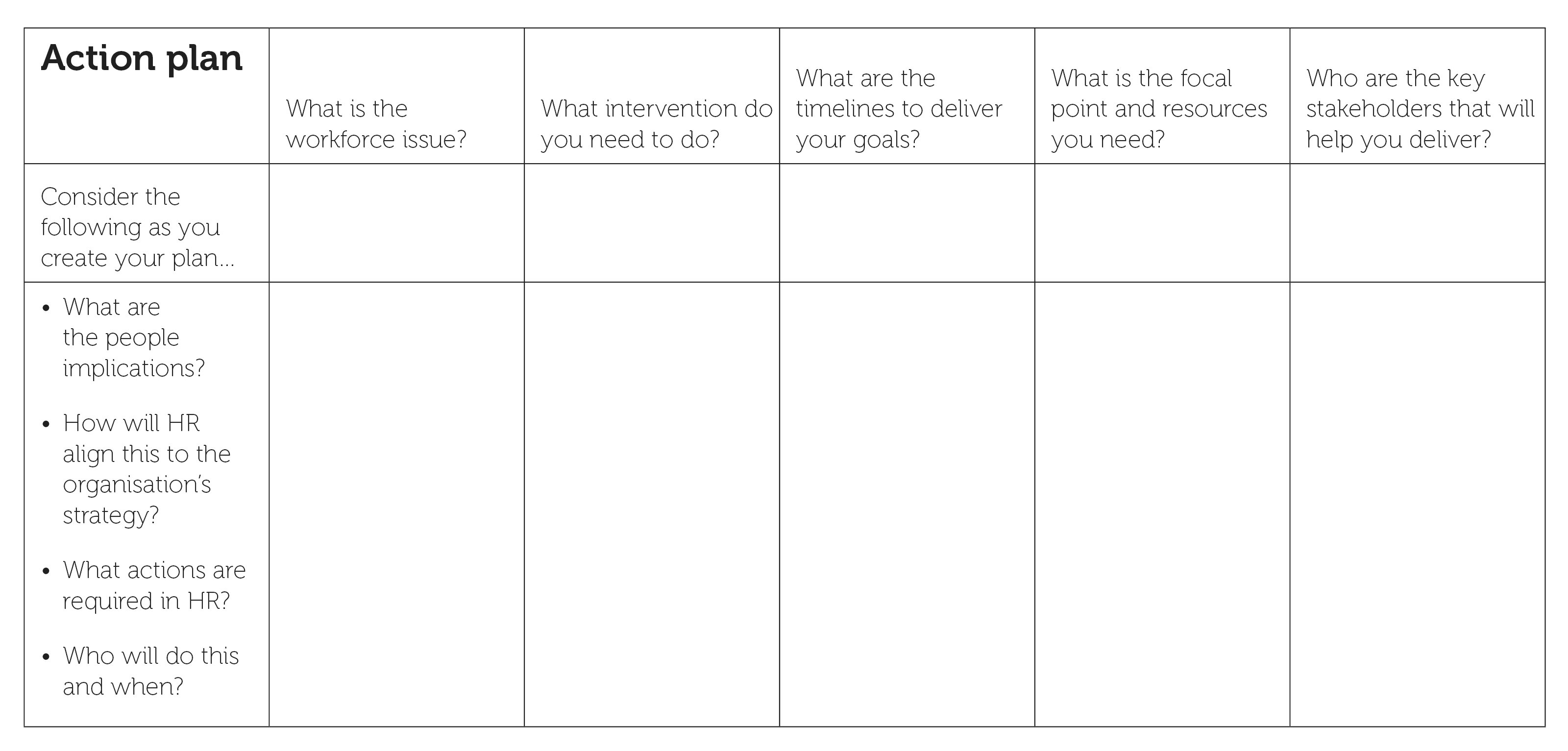What is it?
The action plan is where you establish the best way to close the skills and capability gaps identified between supply and demand.
Dave Ulrich and other HR thought leaders developed the workforce planning framework using a number of levers that can help HR and business leaders explore alternatives to closing the gaps. This framework consists of five talent management levers – buy, build, borrow, bind and bounce – and two demand optimisation levers – bot and balance. Sometimes we refer to these as the ‘7Bs’.
The five talent management levers

buy: acquiring the necessary external talent (recruitment, entry schemes, graduates, apprentices, pay and reward)
build: developing internal talent (progression, succession planning, L&D, talent schemes, high potential, diversity, culture)
borrow: contracting, outsourcing or bringing in (secondments, contingent labour, professional services, seasonal temps)
bind: retaining key employees and capabilities (pay and reward, contractual, tenure, return of service)
bounce: removing employees and using performance management (redundancy, redeployment, exits, secondments, partnership schemes).
The two demand optimisation levers

- balance: appropriate combination of the rest (operational transformation, budget, service levels, performance improvement, technology, organisational design)
- bot: use of automation to augment or replace existing capacity or capability (robotic automation, machine learning, cognitive automation).
Why is it important?
Understanding these levers is important, as they can help you formulate a plan and weigh up the alternatives for closing talent gaps. It is a framework that helps HR and business leaders plan their talent needs for the future by critically thinking about what they need to do to ensure they have the right capabilities to deliver the organisation’s strategy.
The five talent management levers
Buy
To buy is an effective method of acquiring new talent, to bring in new capacity and capability on a ‘permanent’ basis – in other words, to recruit. If the other workforce levers discussed below are unable or unsuitable to meet your organisational needs, hiring new recruits, though an expensive option, may still be considered. Consider which roles do you tend to buy in.
In an environment where costs and return on investment will need to be carefully weighed, hiring costs, onboarding and time to productivity for a new recruit will all be important factors in your decision to buy. And that decision should be made with reference to the seven ‘rights’ for your organisation.
Build
Build and develop the talent you have rather than looking to external hires. Building is about developing needed capability internally. This includes all internal and external training courses and development programmes, supporting professional qualifications and studies. Review what talent-building activities you have in place.
Building rather than buying will have a number of benefits. Internal candidates will already have working knowledge of your organisation and its processes, and potentially many of the skills and relationships required to be functional in the role. Developing according to your needs can provide your organisation with a more tailored workforce. Visibly investing in people development and providing a pathway for progression will have the added benefit of improving your Employee Value Proposition (EVP). That said, building is likely to involve talent planning and investment over a longer term, and could be resource-intensive – for example, in creating development programmes, provisions for coaching and mentoring, and so on.
Borrow
Borrow involves borrowing or utilising talent on a temporary basis, such as using contingent labour, consultants or secondments, or outsourcing skills. Consider where the opportunities are to borrow talent.
A way of reducing reliance on the external labour market would be to deploy staff from areas of workforce surplus (or where hiring is easier) to cover current or potential gaps. It will be necessary to test staff’s willingness to change work area and the extent to which retraining might be necessary, as well as its costs.
One option, particularly during times of uncertainty, is to increase the proportion of contingent or casual workers. These could be agency staff, or temporary or fixed-term employees, although these often come at a higher cost. The advantage this offers is ‘numerical flexibility’ – employers can flex workforce numbers more quickly in line with changing demand. The judgement that needs to be made is whether you can secure sufficient resources through these means, and whether this option will be better than permanent hires as set against your assessment of workforce demand.
Bind
Bind is to prevent workers from leaving (either a particular role, business area or organisation) and is a way to fix capacity and capability within the organisation. Typical approaches are to increase pay and reward, other retention schemes to improve conditions and incentivise longer service (for example additional annual leave), or include restrictive clauses in contracts. Consider how effective your retention strategy is at helping you retain key talent.
Bounce
This is the opposite of bind – it is to move someone around or out of the organisation quickly enough. This is where you move capacity and capability either internally or externally. Consider how effective you are at moving people around.
This can include:
- redeployment (and use with build, reskilling of workers)
- exits (redundancy, and removing low or underperforming individuals through your performance management process)
- secondments
- partnership schemes with other organisations (often in the same group) to move resource around.
The two demand optimisation levers
Balance
Balance ensures demand factors are reduced and balanced to align with the business strategy and your ability to implement change effectively. Consider how you can achieve the right balance or combination of the different approaches.
The importance of balancing and considering your costs is key to providing evidence as a base for any of your workforce initiatives. You need to highlight what the benefits are to the business and where you will be adding value.
Consider the following areas when it comes to balance:
- How well are you able to balance the demands in the way your organisation is designed?
- How balanced are the levels of hierarchy in your organisation? Are there too many layers and are demands on the spans of control untenable?
- How are you going to balance the demands of your strategy if it is not aligned?
Bot
Bot is the use of automation to augment or replace existing capacity or capability in the organisation.
An obvious way to reduce exposure to labour availability problems is to reduce dependence on people through some form of automation. Clearly, this will be a more appropriate option for some jobs, or parts of jobs, than others in the short term, but it is possible that many routine and repetitive jobs can be replaced by technological interventions over the medium term. By contrast, roles that involve ‘genuine creativity’, ‘building complex relationships with people’ and that are ‘highly unpredictable’ would not be suitable candidates.
If your labour source is interrupted or becomes more expensive, automation could provide a cost saving as well. However, decisions should reflect consideration of employment relationships, ethical responsibilities and appropriate workforce consultations.
What can you do?
Consider which levers you will pull to start developing action plans
What should you stop doing, start doing or continue doing under each of the workforce planning levers? The ideal state is to achieve a combination and balance of these levers to meet workforce demands. Remember the critical roles you identified earlier and recognise how you are using or could use the levers for better critical roles management. It is essential that the business owns the action plan and that HR enables and facilitates the plan.
Determine what you need to execute the plan
The initial plan needs to do three things:
- Detail the outcomes from the plan and the timelines.
- Provide:
- options (for example if sharing with key stakeholders, it can be beneficial to provide three options for them to choose, based on cost/timeframe)
- scenarios (for example, if our objectives are that, this is the plan; if our objectives are different, this is the alternative plan).
- Describe the journey to stakeholders. You need to be able to articulate the story in a compelling way.
Ensure success by establishing your key stakeholders
You need to consider who the primary stakeholders are that you need to influence, get on board, and collaborate with to help you with your workforce plans.
Typical stakeholders include:
- operational leads
- HR business partners and centres of excellence
- finance
- commercial and procurement
- IT/digital
- estates/facilities
- unions.
Understand what key components are needed
A typical action plan will include some of the following components:
- a demand management plan – to manage and optimise demand on an enduring basis
- a recruitment plan – of all permanent and contingent requirements
- an L&D plan – with all the learning interventions
- a redeployment plan – including promotions
- a relocation/estates plan – and possibly an outsourcing plan – all aspects
- where demand will be serviced by an external provision
- a number of non-business-as-usual projects – including automation and other one-off interventions.
Execute the plan using an action plate template
Once you’ve established what you need in your plan, you can then bring it all together. Use an action plan template, like the one below, to do so (you can print the table or recreate and adapt the table to suit your needs). An action plan template helps you understand what your key workforce issues and gaps are by consolidating them into one place.
In doing so, it helps you answer questions such as:
- What are the workforce gaps and issues to be addressed?
- What talent interventions will you use to address these?

Once your plan’s established, you can then move on to delivering it.







